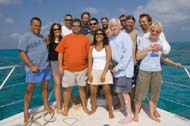| I went back for my "Fourth Annual" with Jim Abernethy’s Scuba Adventures in May, again looking for shark photo opportunities (scroll down on this blog to see the reports on the Third and Second Annual Shark Fest trips). Why did I do it again? For one thing, I can’t think of another operator who has consistently exceeded my expectations every time I’ve been out with him–and yes, Jimmy and his crew did it AGAIN this year! (561-842-6356; www.scuba-adventures.com) Second, this was a "different" trip. Rather than going on an overnight run out of West Palm to the waters off Grand Bahama Island for the shark "usual suspects" (though we did go for those on the way back as well), on this trip we traveled for two days and about 300 miles to far southeast Bahamas, in an area known as the Tongue of the Ocean. We were looking for a specific species of shark that I’d never even seen, much less photographed, in my 35 years of diving–the Oceanic Whitetip (Carcharhinus longimanus).
The Oceanic Whitetip is stocky and bulky, but can grow to 13ft in length, and will be confused in name only with the small, harmless and (in some spots) common-as-flies White-tipped Reef Shark (Triaenodon obesus). The Oceanic Whitetip is easily identified with its large, paddle-like pectoral fins, which are significantly larger than most other shark species and conspicuously rounded. There are at least a couple of reasons why I’d never seen one: (1) they are a "pelagic" shark, which means they prefer off-shore, deep-ocean areas–not likely to be spotted on the shallow reefs we divers frequent; and (2) there are a lot less of them to see–those large fins are highly valued as the chief ingredient of shark-fin soup–and studies have shown this shark’s population declining anywhere from 70 to +90 percent, depending on the area, due to longline fishing. |
|
|

|
Since it was a two-day trip to get where we were going, Jimmy stopped on the way at the site of the Theo, a wreck lying on its port side at a depth of 90-110 feet. Not many schools of fish on this “artificial reef” as yet, but an interesting dive. |
|

|
So this is how it worked. Since these are pelagic sharks, the crew would put out a float in the “blue water” with these sealed milk crates attached and filled with bait. We had success from the very first day of our arrival, and for each of the five days we spent in this area, both the weather and the number of shark photo opportunities seemed to improve. Divers and bait crates would essentially drift with the current, the sharks coming and going. It was a tad unnerving when you had to keep your eye on multiple sharks, and no reef to hide in. There was also a slight problem at times when it was windy, as the float would be pushed faster than the current, and we’d spend most of the dive kicking to keep up, pausing for the occasional photo. If it got too windy, Jimmy would just attach a line from the float to the boat to slow things down–and oceanics are NOT a shark that’s intimidated by the presence of the boat–or much of anything else. |
Sorry if the above represents too many shots of the same subject, but oceanics WERE the purpose of this trip, and we did five days of photos with not much else to shoot out there in the blue water. After not having seen one before this trip, I now have a lifetime supply. We felt the trip had been a success after the first day we got there–and then weather, viz, number of sharks, etc. just kept getting better. See how my expectations got exceeded by Jimmy’s operation yet again??
Another aspect worth noting is how cooperative a photo subject the oceanic whitetip is. One source mentions this shark “….makes up for its comparatively leisurely swimming style with an aggressive attitude.” So the shark approaches slowly, allowing you ample time to frame the subject–and then you just watch it come closer and closer in your viewfinder before clicking the shutter. I set a personal trip record for the number of times the dome port on my camera housing was bumped by one of these sharks, but I’d characterize the behavior more as bold/curious than “aggressive.” They were just checking us divers out as a potential meal–nothing personal. Once they determined we were not the source of the fish scent, they would move on–but would come back CLOSE, again and again, just to make sure. Not every diver’s idea of a good time, but a shark photographer’s dream!
No less an authority than the late Jacques Cousteau described the oceanic whitetip as “…the most dangerous of all sharks.” Indeed, this shark is considered responsible for more fatal attacks on humans than all other shark species combined. This statement needs a Barry Bonds Home Run Record-sized asterisk, however. Because this is an open ocean shark, these fatalities are usually a result of predation on injured, bleeding people from shipwrecks or downed aircraft. For example, oceanics are deemed responsible for many of the 60-80 sailor shark deaths after the sinking of the USS Indianapolis in 1945 (remember that description by the Robt. Shaw character in the movie Jaws?) Such incidents are not included in common shark-attack indices, and of course the near-shore unprovoked attacks by great whites, tigers and bull sharks receive much notoriety. Since we were not “perceived as prey,” we didn’t really feel threatened, although we kept a watchful eye on every shark approach, and it probably wouldn’t have been a good idea to go in the water if you’d cut yourself shaving that morning. :>) .. |
|
|
|
Oceanic whitetips usually roam in isolation from their own species, but have been observed with pilot fish, dolphin fish, remoras and even pilot whales. We saw several sharks accompanied by small schools of pilot fish (Naucrates ductor) and others with rainbow runners (Elagatis bipinnulata)–another open water fish (jack family) rarely seen over reefs. |
|

|
We named this juvenile oceanic “Peanut.” The perspective is distorted a bit in the above photo with the diver in the background–she’s a lot smaller than she looks. The pups are born at a length of 26 to 30 inches, and she was about 3 & 1/2 feet long, so this was a young shark! Watching her navigating with those outsized pectoral fins she had yet to grow into was like watching a puppy golden retriever learning to run without tripping over its own big paws. |
|
|
|
Once we had our fill of Oceanic whitetips, we visited some other sites. These shots are from Allen’s Cay in the northern Exuma chain. It’s a popular anchorage, less than a day’s sail south of Nassau, and the scenes are more typical of what most people expect to see on a Bahamas vacation! The Allen’s Cay Rock Iguana (Cyclura cychlura inornata) feeds on fruits, leaves and flowers of the plants on this tiny island.
|
|

|
We did a dive on a blue hole near Nassau, but the viz in the hole was terrible, so we mostly poked along the rim, doing reef shots in about 30 feet of water. |
|
|
And then there was (of course!) a stop on the way back at Tiger Beach, the main location for my prior Bahamas Shark Fest blogs. You know things are normal when you see the lemon sharks (Negaprion brevirostris) circling on the surface after the crew hangs bait crates off the boat’s stern. We also “wrangle” the sharks in with bait attached to fishing lines–if you click on the above shot on the right to enlarge it, you may see the bait fish in the lemon shark’s mouth.
|

|
| Laugh if you will (and I’m sure you will), but all guests and crew worked to hook these small fish. They played an important role in bringing in the sharks, as noted in the paragraph and two photos just above this portrait of the proud fisherman and his catch (thanks to Jim Abernethy for the shot). |
|
Underwater shots of lemon sharks.

|
The above photo shows behavior I’ve seen a few times before, and commented on in last year’s Shark Fest blog. A lemon shark will suddenly just stop, and open its mouth to allow itself to be cleaned by the sharksuckers (Echeneis naucrates–remora family) which are usually attached to the shark. The shark creates its own “cleaning station!” |
|
|
And what would Tiger Beach be without tiger sharks (Galeocerdo cuvier)? One of the highlights of our trip was the return of Emma (first three photos above), the star of my very first blog posts from our “Second Annual” trip here. Emma was docile as ever, coming close but not exhibiting any threatening behavior. The only difference is that she’s even bigger (about 14 feet now) and really HUGE around (maybe pregnant?) The photo on the lower right is of another tiger on the scene–not as big as Emma, but not at all shy about coming close, either. |
|
|
We then spent some time at a place Jimmy calls Carcharhinus Cut. Similar to the site we dove last year called the Mother Lode, it’s an opportunity to photograph Caribbean Reef Sharks (Carcharhinus perezi) with the colorful reef. The photo on the right, above served as a kind of reminder to me–should we divers be emulating the behavior of those fish hiding in the reef? :>).. |
|
|
As usual, we also had fabulous Bahamas sunsets to photograph–a good point at which to end this blog post. The group shot photo above is courtesy of Jim Abernathy.
I now have photos of all the “Big Five” shark species–great white, tiger, oceanic whitetip, bull and great hammerhead (www.seaimages.org), click on “Photo Examples” than click on “Sharks” for more)–and all except the great white shots were taken on Jim Abernethy trips. Many thanks to Jimmy and crew members Wade, Don, John and Ed for another fantastic trip! I’ll be back next year!
Best to all,
Ken |
|
|
|
|

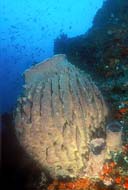
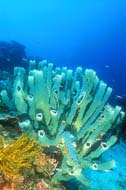



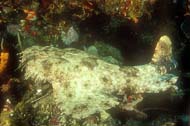
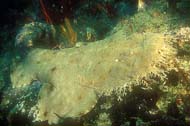



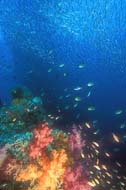

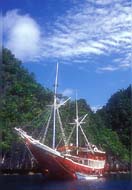









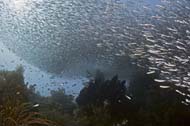

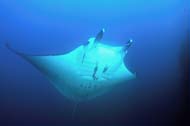
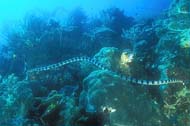
 Permalink
Permalink Filed under:
Filed under: 































